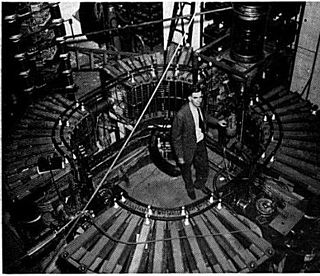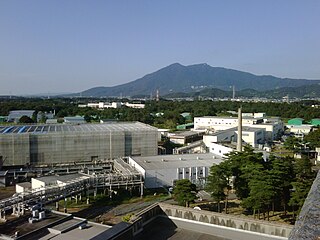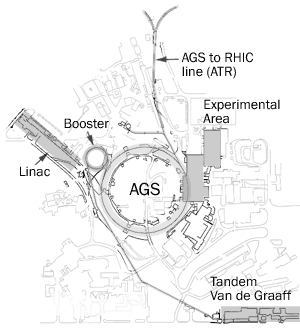
Particle physics or high-energy physics is the study of fundamental particles and forces that constitute matter and radiation. The field also studies combinations of elementary particles up to the scale of protons and neutrons, while the study of combination of protons and neutrons is called nuclear physics.

Brookhaven National Laboratory (BNL) is a United States Department of Energy national laboratory located in Upton, Long Island, a hamlet of the Town of Brookhaven. It was formally established in 1947 at the site of Camp Upton, a former U.S. Army base. Located approximately 60 miles east of New York City, it is managed by Stony Brook University and Battelle Memorial Institute.

Argonne National Laboratory is a federally funded research and development center in Lemont, Illinois, United States. Founded in 1946, the laboratory is owned by the United States Department of Energy and administered by UChicago Argonne LLC of the University of Chicago. The facility is the largest national laboratory in the Midwest.

A synchrotron is a particular type of cyclic particle accelerator, descended from the cyclotron, in which the accelerating particle beam travels around a fixed closed-loop path. The magnetic field which bends the particle beam into its closed path increases with time during the accelerating process, being synchronized to the increasing kinetic energy of the particles.

Gargamelle was a heavy liquid bubble chamber detector in operation at CERN between 1970 and 1979. It was designed to detect neutrinos and antineutrinos, which were produced with a beam from the Proton Synchrotron (PS) between 1970 and 1976, before the detector was moved to the Super Proton Synchrotron (SPS). In 1979 an irreparable crack was discovered in the bubble chamber, and the detector was decommissioned. It is currently part of the "Microcosm" exhibition at CERN, open to the public.

Jack Steinberger was a German-born American physicist noted for his work with neutrinos, the subatomic particles considered to be elementary constituents of matter. He was a recipient of the 1988 Nobel Prize in Physics, along with Leon M. Lederman and Melvin Schwartz, for the discovery of the muon neutrino. Through his career as an experimental particle physicist, he held positions at the University of California, Berkeley, Columbia University (1950–68), and the CERN (1968–86). He was also a recipient of the United States National Medal of Science in 1988, and the Matteucci Medal from the Italian Academy of Sciences in 1990.

The High Energy Accelerator Research Organization, known as KEK, is a Japanese organization whose purpose is to operate the largest particle physics laboratory in Japan, situated in Tsukuba, Ibaraki prefecture. It was established in 1997. The term "KEK" is also used to refer to the laboratory itself, which employs approximately 695 employees. KEK's main function is to provide the particle accelerators and other infrastructure needed for high-energy physics, material science, structural biology, radiation science, computing science, nuclear transmutation and so on. Numerous experiments have been constructed at KEK by the internal and international collaborations that have made use of them. Makoto Kobayashi, emeritus professor at KEK, is known globally for his work on CP-violation, and was awarded the 2008 Nobel Prize in Physics.

High-energy nuclear physics studies the behavior of nuclear matter in energy regimes typical of high-energy physics. The primary focus of this field is the study of heavy-ion collisions, as compared to lighter atoms in other particle accelerators. At sufficient collision energies, these types of collisions are theorized to produce the quark–gluon plasma. In peripheral nuclear collisions at high energies one expects to obtain information on the electromagnetic production of leptons and mesons that are not accessible in electron–positron colliders due to their much smaller luminosities.

The Super Proton Synchrotron (SPS) is a particle accelerator of the synchrotron type at CERN. It is housed in a circular tunnel, 6.9 kilometres (4.3 mi) in circumference, straddling the border of France and Switzerland near Geneva, Switzerland.

The Bevatron was a particle accelerator — specifically, a weak-focusing proton synchrotron — at Lawrence Berkeley National Laboratory, U.S., which began operating in 1954. The antiproton was discovered there in 1955, resulting in the 1959 Nobel Prize in physics for Emilio Segrè and Owen Chamberlain. It accelerated protons into a fixed target, and was named for its ability to impart energies of billions of eV.

The Proton Synchrotron is a particle accelerator at CERN. It is CERN's first synchrotron, beginning its operation in 1959. For a brief period the PS was the world's highest energy particle accelerator. It has since served as a pre-accelerator for the Intersecting Storage Rings (ISR) and the Super Proton Synchrotron (SPS), and is currently part of the Large Hadron Collider (LHC) accelerator complex. In addition to protons, PS has accelerated alpha particles, oxygen and sulfur nuclei, electrons, positrons, and antiprotons.
George Ernest Kalmus, CBE, FRS is a noted British particle physicist.

The Alternating Gradient Synchrotron (AGS) is a particle accelerator located at the Brookhaven National Laboratory in Long Island, New York, United States.
J-PARC is a high intensity proton accelerator facility. It is a joint project between KEK and JAEA and is located at the Tokai campus of JAEA. J-PARC aims for the frontier in materials and life sciences, and nuclear and particle physics. J-PARC uses high intensity proton beams to create high intensity secondary beams of neutrons, hadrons, and neutrinos.

The Big European Bubble Chamber (BEBC) is a large detector formerly used to study particle physics at CERN. The chamber body, a stainless-steel vessel, was filled with 35 cubic metres of superheated liquid hydrogen, liquid deuterium, or a neon-hydrogen mixture, whose sensitivity was regulated by means of a movable piston weighing 2 tons. The liquids at typical operation temperatures around 27 K were placed under overpressure of about 5 standard atmospheres (510 kPa). The piston expansion, synchronized with the charged particle beam crossing the chamber volume, caused a rapid pressure drop; in consequence the liquid reached its boiling point. During each expansion, charged particles ionized the atoms of the liquid as they passed through it and the energy deposited by them initiated boiling along their path, leaving trails of tiny bubbles. These tracks were photographed by the five cameras mounted on top of the chamber. The stereo photographs were subsequently scanned and all events finally evaluated by a team of scientists. After each expansion, the pressure was increased again to stop the boiling. The bubble chamber was then ready again for a new cycle of beam exposure.

A particle accelerator is a machine that uses electromagnetic fields to propel charged particles to very high speeds and energies to contain them in well-defined beams. Small accelerators are used for fundamental research in particle physics. Accelerators are also used as synchrotron light sources for the study of condensed matter physics. Smaller particle accelerators are used in a wide variety of applications, including particle therapy for oncological purposes, radioisotope production for medical diagnostics, ion implanters for the manufacture of semiconductors, and accelerator mass spectrometers for measurements of rare isotopes such as radiocarbon.
A Fixed-Field alternating gradient Accelerator is a circular particle accelerator concept that can be characterized by its time-independent magnetic fields and the use of alternating gradient strong focusing.

John M. "Jack" Carpenter was an American nuclear engineer known as the originator of the technique for utilizing accelerator-induced intense pulses of neutrons for research and developing the first spallation slow neutron source based on a proton synchrotron, the Intense Pulsed Neutron Source (IPNS). He died on 10 March 2020.

The Accelerator Neutrino Neutron Interaction Experiment (ANNIE) is a proposed water Cherenkov detector experiment designed to examine the nature of neutrino interactions. This experiment will study phenomena like proton decay, and neutrino oscillations, by analyzing neutrino interactions in gadolinium-loaded water and measuring their neutron yield. Neutron Tagging plays an important role in background rejection from atmospheric neutrinos. By implementing early prototypes of LAPPDs, high precision timing is possible. The suggested location for ANNIE is the SciBooNE hall on the Booster Neutrino Beam associated with the MiniBooNE experiment. The neutrino beam originates in Fermilab where The Booster delivers 8 GeV protons to a beryllium target producing secondary pions and kaons. These secondary mesons decay to produce a neutrino beam with an average energy of around 800 MeV. ANNIE will begin installation in the summer of 2015. Phase I of ANNIE, mapping the neutron background, completed in 2017. The detector is being upgraded for full science operation which is expected to begin late 2018.
Harold Matthew Spinka Jr. was an American physicist, specializing in experimental particle physics.
















